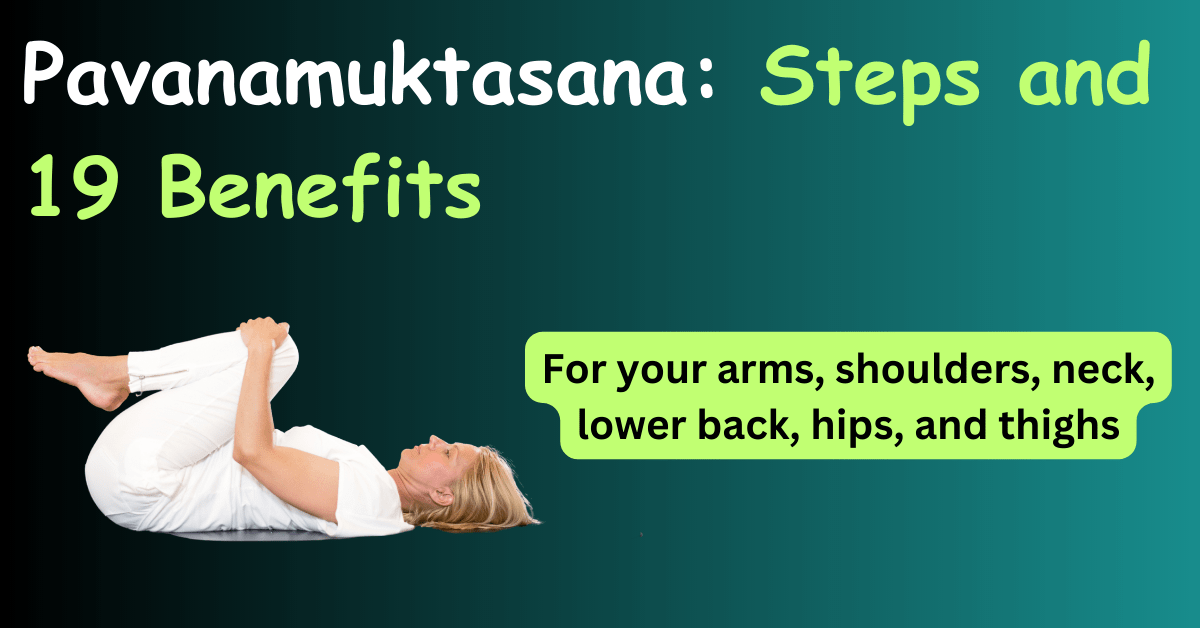Pavanamuktasana is known as the wind-relieving pose. This position is unique because beginners and advanced yoga students may perform it.
Know about Pavanamuktasana benefits and steps to perform it
How to perform Pavanamuktasana?
Pavanamuktasana relieves gas, constipation, and abdominal and pelvic obesity.
First, lie flat on your back with your legs straight. Keep your arms and palms balanced. Straighten your neck, spine, and head. The starting point.
Step 1:
Completely relax in the basic posture.
Bend your knees and lift both legs to your chest slowly.
Step 2:
Take a deep breath.
Exhale entirely and bring your nose to your knees.
After a few weeks of practice, you should be able to touch your knees to your chin instead of your nose.
Step 3:
Extend your left leg.
Hold it for a couple of seconds.
Return to your starting position by releasing your hands and legs.
Step 4:
Remain calm and get back to your starting position.
For optimal results, repeat the asana 3-4 times.
Do:
- Try to touch your chin to your knees.
- Keep your legs together
- In the pose, relax your body and breathe properly.
- Toes should be pointed.
Don’t:
- Put strain on your neck.
- Excessive stretching, attempting to draw the thighs too close together and producing discomfort.
Duration: Begin with 10 seconds and gradually build to one minute.
Benefits of Pavanmuktasana
Pavanamuktasana, or wind-liberating position, has many benefits.
It relieves abdominal stress by releasing digestive gasses from the stomach and intestines. It’s simple and beginner-friendly.
- It stretches your arms, shoulders, neck, lower back, hips, and thighs. Intra-abdominal compression improves circulation.
- This posture speeds intestinal flatus evacuation, relieving flatulence.
- It clears the mind by releasing pollutants.
- Tensing the abdominal muscles and compressing the organs promotes blood circulation and nerve stimulation, improving organ function.
- The abdominal pressure releases prominent intestinal gases.
- All organs receive more blood.
- Improved digestion.
- Constipation relief.
- Loosens vertebrae and strengthens lower back muscles.
- Impotence and sterility.
- Pavanamuktasana relieves constipation, diarrhoea, and acidity.
- Asana develops back, leg, and arm muscles.
- The asana relieves lower back stress.
- Pawanmuktasana improves hip blood flow.
- Asana loosens spinal vertebrae.
- It relieves constipation, flatulence, impotence, and sterility.
- Pawanmuktasana stimulates reproductive systems and pelvic muscles.
- Asana burns fat in the buttocks, thighs, and abdomen.
- This asana stretches the neck and back.
For Women
- Massages pelvic muscles and reproductive organs, helping menstruation disorders.
- Reduces belly, thigh, and buttock fat.
- It treats menstruation issues.
Pavanamuktasana risks and contraindications
- Pavanamuktasana can be very painful for the abdomen. Thus, persons who have had abdominal surgery should avoid it.
- Avoid this asana if you have piles or hernia.
- Pregnant ladies must avoid this asana.
- People with heart, high blood pressure, slipped disc, hyperacidity, menstruation, testicular or back and neck concerns should not practice Pawanmuktasana.
Pavanamuktasana is simple for all ages. Practice this asana consistently to get its benefits once you master it




